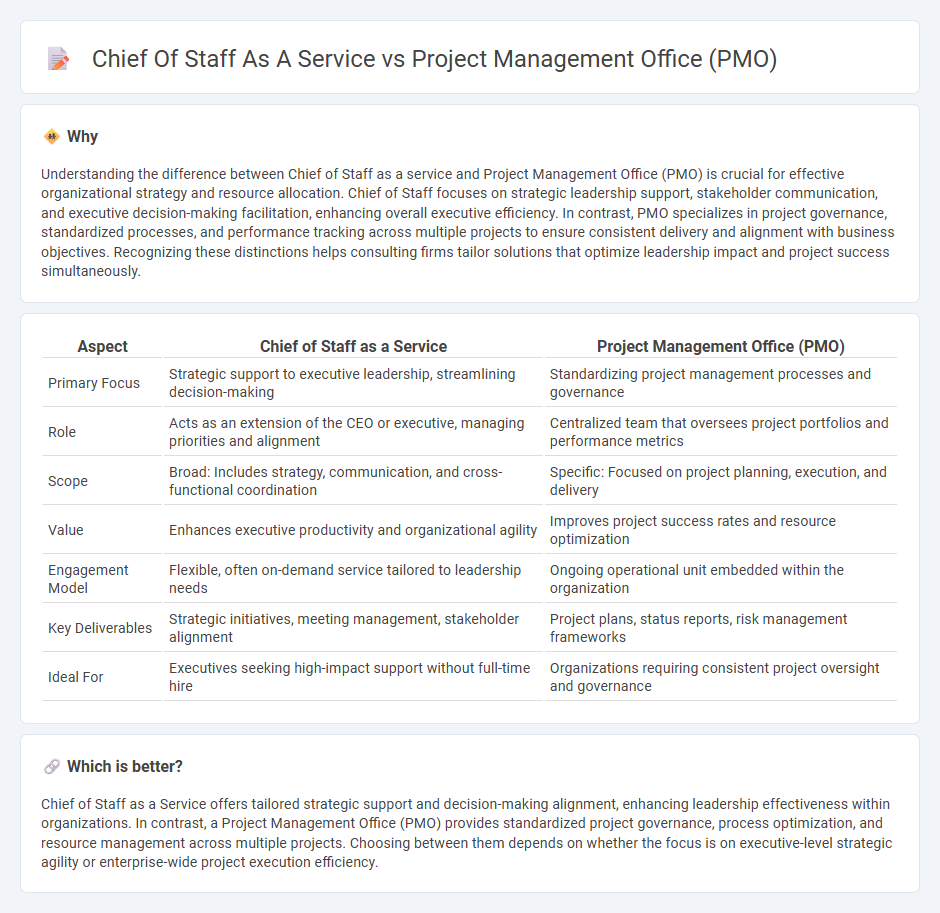
Chief of Staff as a Service offers personalized executive support, strategic alignment, and cross-functional coordination tailored to leadership needs, enhancing decision-making efficiency. In contrast, a Project Management Office (PMO) standardizes project processes, governance, and performance metrics across an organization to ensure consistency and control. Explore how these distinct consulting approaches can transform your organizational effectiveness.
Why it is important
Understanding the difference between Chief of Staff as a service and Project Management Office (PMO) is crucial for effective organizational strategy and resource allocation. Chief of Staff focuses on strategic leadership support, stakeholder communication, and executive decision-making facilitation, enhancing overall executive efficiency. In contrast, PMO specializes in project governance, standardized processes, and performance tracking across multiple projects to ensure consistent delivery and alignment with business objectives. Recognizing these distinctions helps consulting firms tailor solutions that optimize leadership impact and project success simultaneously.
Comparison Table
| Aspect | Chief of Staff as a Service | Project Management Office (PMO) |
|---|---|---|
| Primary Focus | Strategic support to executive leadership, streamlining decision-making | Standardizing project management processes and governance |
| Role | Acts as an extension of the CEO or executive, managing priorities and alignment | Centralized team that oversees project portfolios and performance metrics |
| Scope | Broad: Includes strategy, communication, and cross-functional coordination | Specific: Focused on project planning, execution, and delivery |
| Value | Enhances executive productivity and organizational agility | Improves project success rates and resource optimization |
| Engagement Model | Flexible, often on-demand service tailored to leadership needs | Ongoing operational unit embedded within the organization |
| Key Deliverables | Strategic initiatives, meeting management, stakeholder alignment | Project plans, status reports, risk management frameworks |
| Ideal For | Executives seeking high-impact support without full-time hire | Organizations requiring consistent project oversight and governance |
Which is better?
Chief of Staff as a Service offers tailored strategic support and decision-making alignment, enhancing leadership effectiveness within organizations. In contrast, a Project Management Office (PMO) provides standardized project governance, process optimization, and resource management across multiple projects. Choosing between them depends on whether the focus is on executive-level strategic agility or enterprise-wide project execution efficiency.
Connection
Chief of Staff as a Service and Project Management Office (PMO) are connected through their shared focus on strategic alignment, resource optimization, and performance tracking within an organization. Both roles facilitate effective communication, decision-making, and execution of key initiatives by coordinating cross-functional teams and managing project portfolios. Utilizing Chief of Staff expertise alongside PMO frameworks enhances organizational agility and drives successful delivery of complex projects.
Key Terms
Governance
A Project Management Office (PMO) centralizes governance by standardizing project management processes, ensuring alignment with organizational objectives, and providing oversight for risk and resource management. The Chief of Staff as a service emphasizes strategic governance by facilitating executive decision-making, coordinating cross-department initiatives, and enhancing communication flow to enable agile leadership. Explore deeper insights on how each approach optimizes governance frameworks tailored to your organization's needs.
Strategic Alignment
The Project Management Office (PMO) ensures strategic alignment by standardizing project processes and tracking key performance indicators to meet organizational goals efficiently. Chief of Staff as a service enhances strategic alignment through direct executive collaboration, decision-making facilitation, and cross-functional communication that supports leadership priorities. Discover how integrating both roles can optimize your company's strategy execution and operational effectiveness.
Operational Execution
The Project Management Office (PMO) centralizes project governance, resource allocation, and standardized methodologies to ensure consistent operational execution across multiple projects. Chief of Staff as a service offers strategic coordination, cross-functional alignment, and executive support tailored to accelerate business priorities and decision-making processes. Explore the differences and benefits of each approach to enhance your organization's operational excellence.
Source and External Links
Project Management Office (PMO) - Planisware - A PMO is a department that standardizes project management processes, shares resources and best practices, and can act as a strategic advisor to improve project performance and decision-making.
Project management office - Wikipedia - The PMO defines and maintains standards for project management within organizations, aiming to standardize execution and improve project success through established methodologies and metrics.
What is PMO? Definition, Types and It's Role | IPM - The PMO ensures projects align with company strategy by standardizing governance, supporting project managers with methodologies and tools, and facilitating resource sharing to improve project outcomes.
 dowidth.com
dowidth.com